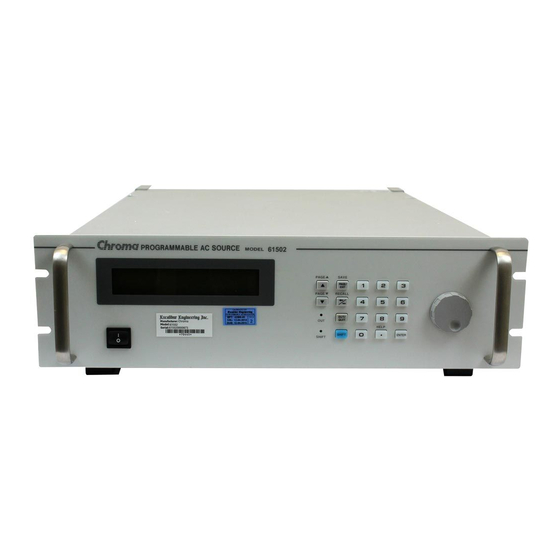
Table of Contents
Advertisement
Quick Links
Advertisement
Table of Contents
Troubleshooting

Summarization of Contents
Safety Summary
Before Applying Power
Verify power input matches rated input.
Protective Grounding
Ensure proper connection to prevent electric shock.
Necessity of Protective Grounding
Do not cut or disconnect grounding wires to avoid hazards.
Fuses
Use only specified fuses and do not repair or short-circuit holders.
Explosive Atmosphere Warning
Do not operate in flammable gas environments; ensure good ventilation.
Cover Removal Warning
Only qualified personnel should remove instrument covers for replacement.
Safety Symbols
Danger: High Voltage
High voltage hazard; refer to manual for explanation.
High Temperature
Indicates high temperature; do not touch to avoid injury.
Protective Grounding Terminal
Terminal must be connected to ground before operation for shock protection.
Warning Sign
Draws attention to practices that could cause personal injury if not followed.
Caution Sign
Highlights hazards that may result in personal injury or death if not heeded.
Protection Plates
Installation Instructions
Steps to install rear panel protection plates for transport safety.
General Information
Introduction
Overview of the Chroma AC source series and its capabilities.
Key Features
Highlights of the AC source's configuration and input/output capabilities.
Specifications
Detailed technical specifications for the AC source models.
Names of Parts
Front Panel
Identification and description of front panel components and controls.
Rear Panel
Identification and description of rear panel connectors and interfaces.
Installation
Inspection
Procedures for inspecting the instrument after unpacking.
Preparation for the Use
Requirements for setting up the instrument for operation.
Requirements of Input Power
Details on voltage, frequency, and current ratings for power connection.
Output Connection
Guidelines for connecting the load to the output terminals.
Remote Sense Connection
Explanation of how to use the remote sense function for accurate voltage delivery.
Procedures of Power-on
Step-by-step guide for powering on the AC source and its self-test.
I/O Connectors (Option)
Description of optional input/output connectors.
Local Operation
Introduction
Overview of operating the AC source locally via keypad and RPG.
Operation through Keypad and RPG
Guide to using the front panel controls for programming and testing.
MAIN PAGE (Output Setting and Measurement)
Description of the primary display screen for output and measurements.
CHOICE PAGE (Functional List Choice)
Navigating through the functional lists via the CHOICE PAGE.
SETUP Functional List
Configuration options for setting parameters like Range, Limits, Relay, etc.
CONF Functional List
Configuration settings for remote inhibit, external voltage, and coupling.
OUTPUT Functional List
Lists and describes the various output functions available like Couple Mode, Degree, Impedance.
Save and Recall
Modes for saving and recalling output settings and system data.
Protection
Overview of hardware and software protections and their descriptions.
Calibration
Introduction
Overview of the calibration process and required instruments.
MANUAL CALI Functional List
Accessing the calibration menu and entering the password.
Output Voltage and Voltage Measurement Calibration
Procedure for calibrating output voltage accuracy.
Current Measurement Calibration
Procedure for calibrating current measurement accuracy.
External Vref Calibration
Procedure for calibrating the external voltage reference input.
Application
General
Introduction to the AC source's application functions for simulating power line disturbances.
List Mode
Programming output sequences using the LIST mode.
Pulse Mode
Generating pulsed output waveforms with specified duty cycles.
Step Mode
Creating stepped output changes with dwell times.
Harmonic Measurement
Measuring harmonic content of output voltage and current.
Synthesize Waveform
Creating custom waveforms by combining harmonics.
Interharmonics Waveform
Generating waveforms with superimposed sweeping frequencies.
Theory of Operation
General
Overview of the AC source's internal structure and components.
Description of Overall System
Block diagram and explanation of the AC source's system architecture.
Self Test & Troubleshooting
General
Introduction to self-test procedures and troubleshooting.
Self Test
Details of the power-on self-test and error codes.
Troubleshooting
Common problems, reasons, and corrective actions.
Remote Operation
General Information
Overview of remote control capabilities via GPIB and RS-232C.
Setting the GPIB Address and RS-232C Parameters
Configuring communication settings for remote control.
Wire Connection of RS-232C
Pin assignments and connection details for RS-232C interface.
The GPIB Capability of the AC Source
Description of GPIB interface functions and states.
Introduction to Programming
Conventions and formats for programming commands.
Basic Definition
Explanation of command tree structure and terminology.
Traversal of the Command Tree
Methods for navigating and specifying commands.
Execution Order
Order in which commands are processed by the AC source.
The Commands of the AC Source
Comprehensive guide to SCPI commands for the AC source.










Need help?
Do you have a question about the 61502 and is the answer not in the manual?
Questions and answers